The first time she came to the RESNA conference as a student design competition finalist, Jane Hankins thought she was in way over her head. “I remember sitting there, after we made our presentation to the judges, and wondering what were we doing there,” she said. “Everyone was so savvy and smart. Here I am, a special educator with all these engineers. It was intimidating.”
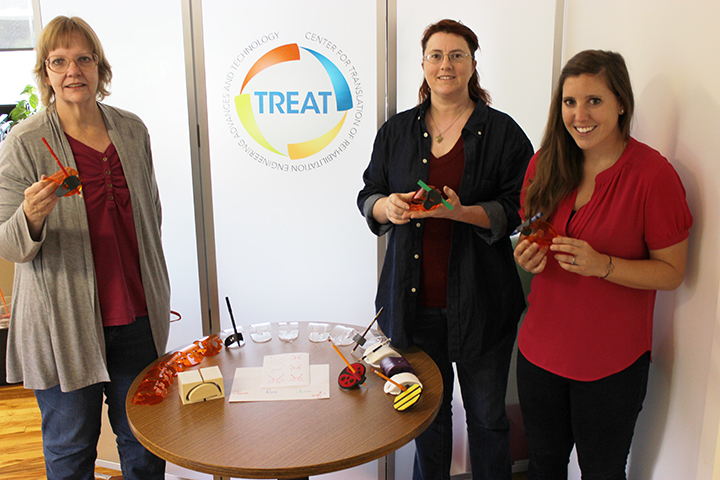 But that didn’t stop her, or her teammates, Jennifer Black and Roxanne Chandler (from left to right in the photo at left). Students in the special education program at California Lutheran University, they caught the bug – the Doodle Bug, that is. Jane and her team won the award for “Technology Most Likely to Become Commercially Available” at the 2013 RESNA Student Design Competition with the Doodle Bug Writing Aid, a small, inexpensive device that allows those with hand injuries, congenital malformations, or arthritis to hold a pen or pencil and write independently. The award came with a $500 cash prize and an internship at the Center for the Translation of Rehabilitation Engineering Advances and Technology (TREAT) which included a $5,000 budget to further develop the product.
But that didn’t stop her, or her teammates, Jennifer Black and Roxanne Chandler (from left to right in the photo at left). Students in the special education program at California Lutheran University, they caught the bug – the Doodle Bug, that is. Jane and her team won the award for “Technology Most Likely to Become Commercially Available” at the 2013 RESNA Student Design Competition with the Doodle Bug Writing Aid, a small, inexpensive device that allows those with hand injuries, congenital malformations, or arthritis to hold a pen or pencil and write independently. The award came with a $500 cash prize and an internship at the Center for the Translation of Rehabilitation Engineering Advances and Technology (TREAT) which included a $5,000 budget to further develop the product.
TREAT, based in Lebanon, New Hampshire, is a center within SIMBEX, a product development company that engineers human solutions for treatment and prevention of diseases and disabilities. TREAT is part of the National Institutes of Health (NIH) R24 network of rehabilitation research resource centers, funded through the National Center for Medical Rehabilitation Research (NCMRR) in the Eunice Kennedy Shriver National Institute of Child Health and Human Development (NICHD). TREAT has been a sponsor of the RESNA Student Design Competition since 2012.
The Doodle Bug team arrived in New Hampshire, excited and nervous, for their week-long internship on July 5th. Josh Page, Senior Industrial Design Engineer, was their mentor during their stay. “It was a pretty intense week,” he said. “We worked through all phases of product development – the technology and market assessment, defining product requirements, and evaluating methods for product manufacturing and supplier sourcing." One of the highlights was a brainstorming meeting held with engineers, designers and business development staff at Simbex. “That was really energizing, to have all of these creative people in one room focused on our design,” said Jane. “They just came up with so many ideas, everything from the size of the device for children to how to market it.”
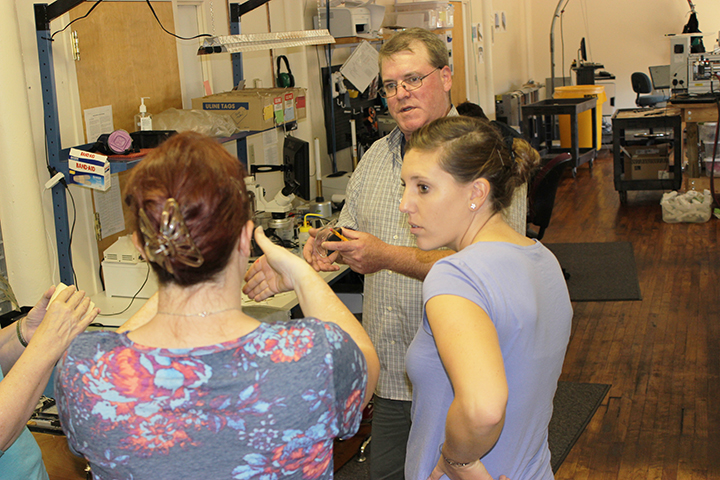 The team also met with Jerry Weisman, a RESNA Fellow and instigator of the TREAT award. “Meeting with Jerry was really pivotal,” said Jane. “He really understood that we’re teachers and this is all very intimidating. He helped us break down the business plan into manageable parts.” Jerry and the team discussed realistic goals. “We talked about not starting a company and hoping to make millions of dollars and retire to the Bahamas,” said Jerry. “They could do a limited run and go to an OT conference, sell the device and get more feedback. That’s more realistic than going to China and making 10,000 at once.”
The team also met with Jerry Weisman, a RESNA Fellow and instigator of the TREAT award. “Meeting with Jerry was really pivotal,” said Jane. “He really understood that we’re teachers and this is all very intimidating. He helped us break down the business plan into manageable parts.” Jerry and the team discussed realistic goals. “We talked about not starting a company and hoping to make millions of dollars and retire to the Bahamas,” said Jerry. “They could do a limited run and go to an OT conference, sell the device and get more feedback. That’s more realistic than going to China and making 10,000 at once.”
The fact that the team did not have an engineering background was not an obstacle. “At TREAT, only a small percentage of clients are engineers, so we’re accustomed to that education process, “ explained Josh. “We introduced them to some new tools and technologies. It’s amazing how quickly people pick this stuff up.” And pick it up they did. Over the course of the week, Doodle Bug underwent several design iterations, moving incredibly fast from the original mock-up – an arts and crafts project of felt, glue, and ball bearings – to a sleek, colorful and attractive product.
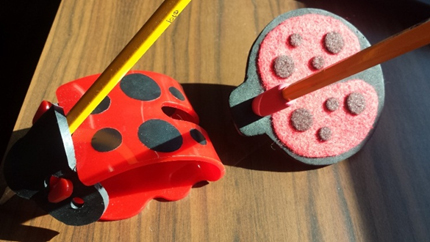 “The original prototype allowed too many degrees of freedom, so it was difficult to control, and didn’t hold the writing implement securely,” explained Josh. “We came up with a simple design that would be easy to manufacture and much less complicated.” The new design incorporated laser cutting and acrylic, which was heated and fitted over a form to create the “bug.” The number of parts was cut in half, from four to two. “That’s when I realized that I could actually do this,” said Jane. “Our technical level went way up as a result of the internship.” When she returned to California, Jane joined TechShop, a prototyping and fabrication studio that provides access to tools, software, and space to members. Thanks to TechShop, she has access to a laser cutter, and has already cut the forms for ten more prototypes.
“The original prototype allowed too many degrees of freedom, so it was difficult to control, and didn’t hold the writing implement securely,” explained Josh. “We came up with a simple design that would be easy to manufacture and much less complicated.” The new design incorporated laser cutting and acrylic, which was heated and fitted over a form to create the “bug.” The number of parts was cut in half, from four to two. “That’s when I realized that I could actually do this,” said Jane. “Our technical level went way up as a result of the internship.” When she returned to California, Jane joined TechShop, a prototyping and fabrication studio that provides access to tools, software, and space to members. Thanks to TechShop, she has access to a laser cutter, and has already cut the forms for ten more prototypes.
Doodle Bug now has a future that is looking bright. “Quite honestly, without this internship experience, we probably would have dropped it by now,” said Jane. “But we now have a plan, and we can actually make it ourselves. That’s amazing.” The group has continued to refine the design and has developed additional marketing ideas. “You can customize it so kids can pick a color, have a sticker packet,” said Josh. “It’s a fun little device.” 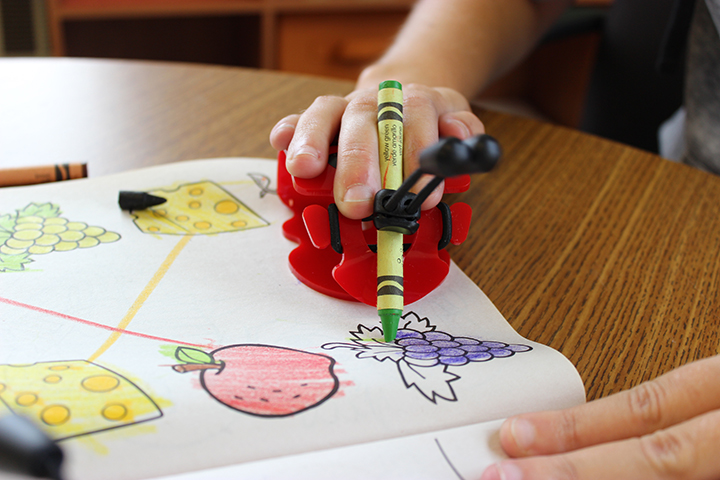 One of the avenues that the team is now exploring is grants, and they’ve just submitted a proposal for additional support from TREAT. “Our mission is to help people commercialize their rehabilitative and assistive technologies,” explained Josh. “We understand the challenges in developing these devices, because the ROI is different. We try to help developers get over that ‘valley of death’ and bring devices to market.”
One of the avenues that the team is now exploring is grants, and they’ve just submitted a proposal for additional support from TREAT. “Our mission is to help people commercialize their rehabilitative and assistive technologies,” explained Josh. “We understand the challenges in developing these devices, because the ROI is different. We try to help developers get over that ‘valley of death’ and bring devices to market.”
And as for advice for future SDC contestants, Jane has this to say: “If you’re lucky enough to be a finalist and come to the conference, be prepared. Print business cards, create a simple website that includes your contact information, and be ready to talk about your product. The people at RESNA are eager to help you, but you’ve got to be able to present your idea well and talk about it.”
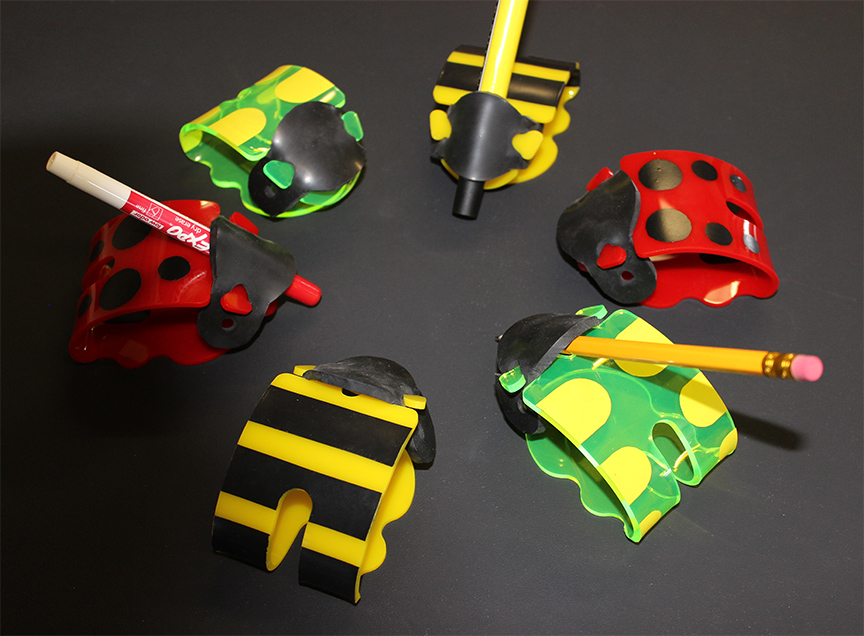 Editor’s Note: Find out more about Doodle Bug on the product website. The 2015 RESNA Student Design Competition is now underway. Registration opens on December 2, with final design submission due April 17, 2015. Click here for details.
Editor’s Note: Find out more about Doodle Bug on the product website. The 2015 RESNA Student Design Competition is now underway. Registration opens on December 2, with final design submission due April 17, 2015. Click here for details.
About TREAT
TREAT is a multidisciplinary, multi-institutional, collaborative consortium that provides infrastructure support and expert consultation to researchers and innovators interested in the translation and commercialization of rehabilitation research applications. TREAT is part of the National Institutes of Health (NIH) R24 network of rehabilitation resource centers (# R24HD065703) and is funded through the National Center for Medical Rehabilitation Research (NCMRR) in the Eunice Kennedy Shriver National Institute of Child Health & Human Development (NICHD). Find out more at: www.simbex.com/TREAT.
About the RESNA Student Design Competition
For over 30 years, the RESNA Student Design Competition has showcased creative and innovative assistive technology designs that help people with disabilities function more independently. Entries are judged on originality, quality of design, and usefulness to persons with disabilities. Several leaders in the field of rehabilitation engineering and assistive technology have gotten their start through this competition. Semi-finalist teams are invited to the RESNA annual conference, where final judging takes place. Every student design competition submission is available on the RESNA Student Design Competition website, where anyone can view the designs in detail, provide feedback, ask questions, and contact the designers directly. Registration for the 2015 competition opens on December 2, 2014, and the final submission deadline is April 17, 2015.